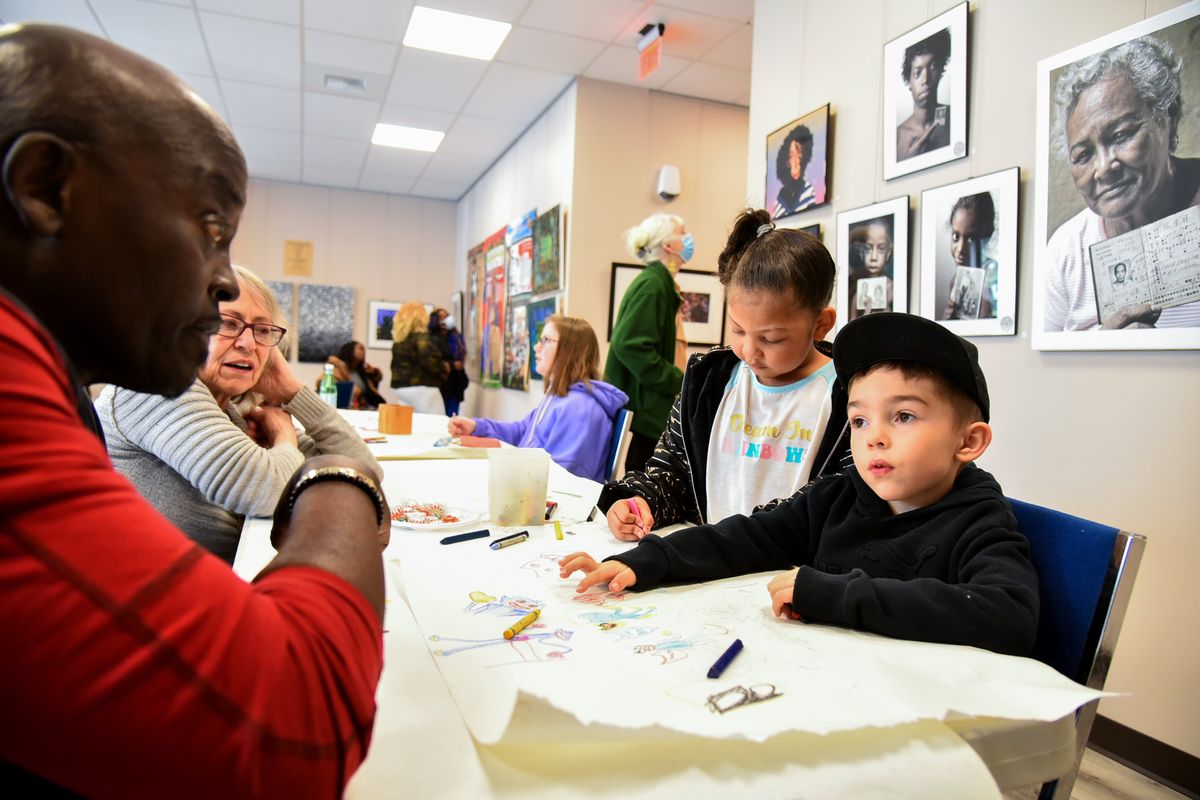‘A lot of talent’: Carl Maxey Center in East Central holds first art exhibit through June 11

The new Carl Maxey Center in Spokane’s East Central neighborhood, designed to be a cultural center focused on Spokane’s Black community, held events Saturday highlighting the center’s first art exhibit that is running through June 11.
The exhibit, titled “Our Stories Our Visions,” was curated by Bob Lloyd, a local artist and photographer who taught at Eastern Washington University for 30 years. “The center just opened up on Feb. 26, so this is the first art show,” he said.
The show includes work from 25 artists and several of them have multiple pieces on display. The pieces include a wide variety of paintings, pencil drawings, photographs, posters and mixed-media pieces. Lloyd said he thought it was important for the Carl Maxey Center to host an art show that highlights minority artists.
“We’ve got a lot of talent out there,” Lloyd said. “This is kind of like a quilt, with all these different squares that show who we are and what we offer. I wanted to see us all in one room.”

Lloyd said there was a lot of interest in the show by artists who sent in applications. “I tried to get a variety of styles and a variety of cultures,” he said.
Despite his intentions, the exhibit was too big for one room. Some of the art is on display at Shotgun Studios at 1625 W. Water Ave. in Peaceful Valley. The gallery is named after the design of the historic home it is in, which features a long, narrow “shotgun” design.
“Our Stories Our Visions” includes four untitled works from the late Mexican-American artist Ruben Trejo, a sculptor and artist who taught at Eastern Washington University for 30 years before he died in 2009. Trejo has two pieces on display at the Smithsonian American Art Museum.
The art show also includes a poem called “Shepherds” by local poet Stephen Pitters that talks about the history of Black Americans, including those known as “Buffalo Soldiers” who fought in the Civil War. “Sooners took advantage in Oklahoma,” it reads. “Later what was gained or taken was stolen by the sticky fingers of the wily privileged. Over a hundred and fifty years later, the same behaviors still exist, though with a different sophisticated twist. The same insult and result happened, steal by any means possible by those seeing themselves as entitled.”
Artist Nicholas Sironka, who goes by Sironka, paints in the batik style. It’s the method of using hot wax and a variety of dye colors to create art on cloth. The dyes are applied in layers with hot wax added in between. “It’s a process of highlighting and eliminating,” Sironka said.
Sironka, who grew up in Kenya in the Maasai tribe, became interested in art as a child when his stepfather gave him paint-by-number kits. “I was really fascinated in how it made me better at blending color,” he said.
When he left Kenya, he realized that there was a lot of incorrect information circulating about the Maasai, Sironka said. He decided that he would make art with a purpose, art that would tell the story of his tribe.
The piece he created that is on display in “Our Stories Our Visions” shows a Maasai woman holding a baby up in the air over her head, looking up at him. It is titled “A Gift from God.” “In my culture, children are a gift from God,” Sironka said.
Sironka, who also teaches art classes for children and adults, said it was important for him to be included in the show because he wants to help spark conversation. “There is a sensitivity with race relations,” he said. “I believe that unless we start somewhere, you won’t get anywhere.”
As children colored next to him, Sironka said he believed in community gatherings like the ones associated with the opening of the art show. “We need to find an avenue of having conversations with each other,” he said.
The art show can be viewed when the Carl Maxey Center at 3114 E. Fifth Avenue is open, which is primarily for events. Check carlmaxeycenter.org or the center’s Facebook page for a schedule. An artist’s reception is scheduled for Friday from 5 p.m. to 8 p.m. at Shotgun Studios, which is open for viewing from 4 p.m. to 9 p.m. every Friday and from 1 p.m. to 4 p.m. every Saturday.